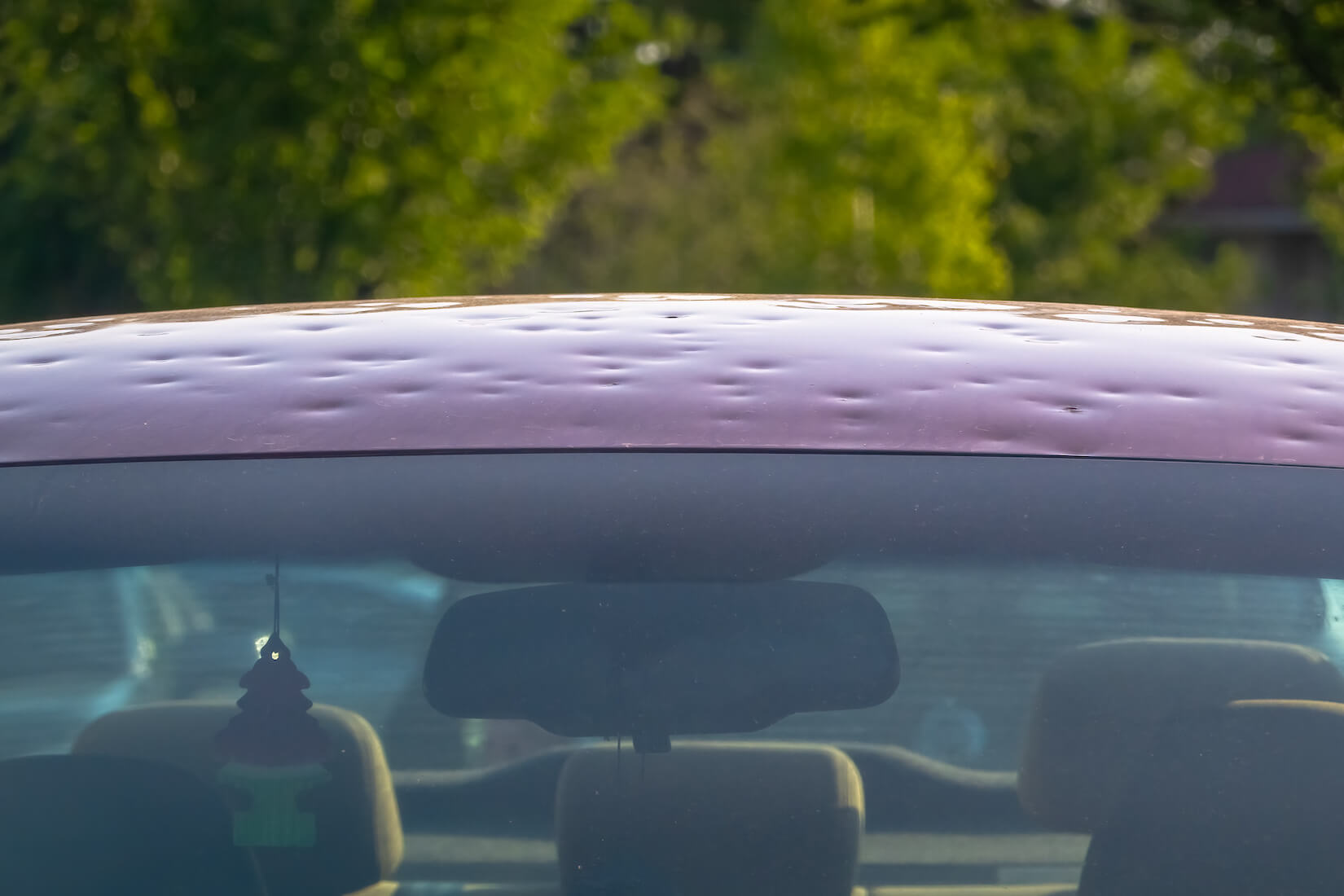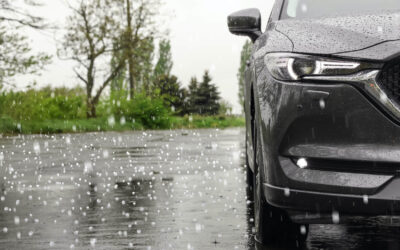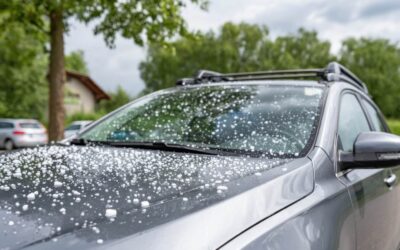Hail damage might not seem like a big deal at first glance, but it can seriously affect your vehicle’s value, insurance eligibility, and even title status. Anyone who’s ever driven through a real hailstorm knows how loud those thuds can be — hailstones flying out of nowhere and slamming into your car, sometimes even cracking your windshield.
Some states, for example, are known for hailstorms, such as Texas and Colorado, particularly in the Denver metro area. If you’ve driven through a bad hailstorm here, you’re probably searching for the best auto hail repair shops in Denver.
In this blog, we’ll learn more about how hail damages your car, how it affects its value, and how it shows up on a CarFax Report.
What is Hail Damage?
Hail is chunks of ice that get tossed around inside thunderclouds (that’s why they are often round) until they’re heavy enough to drop. When they do, they can come down hard — even a quick storm can leave your car covered in dents, cracked glass, and headaches.
Hailstones can range from pea-sized to softball-sized, and the big ones can weigh over a pound. The sheer weight and height from which they drop can cause severe damage in seconds when they fall, sometimes raining down at over 100 mph.
Depending on their size, weight, and how long they fall, hailstones can leave anything from minor dings in your car’s body to major dents that look like baseballs were hurled at it.
Impacts of Hail Damage on Your Vehicle’s Value
Hail can damage your vehicle in many different ways. Some of the most common impacts are:
Cosmetic damage: Cosmetic damage refers to damage on the body of your vehicle that doesn’t affect how it runs. Cosmetic hail damage is still considered body damage, even if minor. This can include small dings, shallow dents, or tiny impressions that are sometimes only noticeable in the right light. You might find them on the hood, roof, body panels, or windshield — anywhere on the vehicle’s exterior.
Structural damage: Structural hail damage means the impact was severe enough to affect parts of the car beyond cosmetic, like bent frame rails, a warped roofline, or compromised crumple zones. It’s the kind of damage that can affect how the car drives, handles, or protects you in a crash.
Mechanical damage: While hail mainly causes cosmetic damage, it can also damage mechanical parts, like cracking windshield wipers, denting the radiator or hood so it doesn’t open properly, or damaging sensors, cameras, or sunroof mechanisms. If water gets in, electronics and wiring can also take a hit.
What is CarFax and Why is it Important
CarFax is not a government watchdog; rather, it’s a privately owned company that compiles vehicle history reports using data from DMVs, insurance companies, repair shops, and other sources.
They collect data from thousands of sources, but no one is legally required to send it in. They get their info from DMVs, insurance companies, police reports, dealerships, and some body shops.
Does Hail Damage Show up on a CarFax Report?
Hail damage can appear on a CarFax and affect the car’s value. For example, insurance companies report accidents and claims because they’re part of CarFax’s data network. When a hail claim or collision is filed, it gets logged and flagged as a “damage event” or “accident report.”
Somebody shops report damage and repairs voluntarily, primarily if they work with insurers or are part of large chains or dealer service departments. On the other hand, independent shops usually don’t bother unless the customer asks.
So if the damage wasn’t claimed through insurance or the shop didn’t report it, it might never show up on the CarFax. That’s why it’s smart to use CarFax as a tool, but not the only one — a physical inspection tells you what the report might miss.
Clean Title vs. Salvage Title: What Hail Damage Can Mean for Your Title
If your vehicle’s severe damage exceeds its value, your insurance company may declare it a total loss. When that happens, the car usually receives a salvage title, even if the damage is only cosmetic.
A salvage title drastically reduces resale value, making insurance or financing more difficult. So it stands to reason you don’t want a salvage title if it can be avoided.
How to Repair a Hail-Damaged Car
Cosmetic hail damage requires specific repair methods, tools, and materials, and is better left to a specialist. Hail damage is usually repaired with paintless dent repair (PDR), which involves gently massaging or popping the dents out from the underside of the panel, roof, or trunk — no repainting, no replacing parts. It’s ideal for minor dings without chipping or cracking paint.
But if the hail damage is more serious, like if the panel is warped, the paint is cracked, or the metal is stretched, body repairers may have to replace entire panels or go the traditional route with filler, sanding, and repainting.
What to Know When Buying a Hail-Damaged Vehicle
Buying a hail-damaged car can be a smart way to save money — if you know what to look for. Some hail damage is purely cosmetic, like minor dings and surface dents, but in other cases, it could involve cracked glass, damaged sensors, or even title issues if the car was declared a total loss by insurance.
Here are a few key things to keep in mind:
- Professional inspection: A clean title doesn’t mean the car is damage-free.
- CarFax report: Check the CarFax report for hail claims, accident history, or title branding.
- Repair documentation: Were the dents pulled? Was it just PDR, or were parts replaced?
- Factor in resale value: The CarFax report will follow the vehicle forever, so if you ever want to sell it or trade it in, you’ll have to contend with the negative report. A hail-damage history may reduce a car’s trade-in or private sale value even if it looks fine now.
Buying a hail-damaged car isn’t automatically a bad idea—but it does require a closer look and a little more due diligence.
Get Your Hail Damage Repaired Today
Hail damage repair is best done by specialists who can repair paintless dents and save you time and money. Some hail damage is extensive, and even though it’s not a flat-out accident or even a fender bender, the damage can still be extensive.
If you’re looking for hail dent repair in Denver, you’re in the right place. Mile High Dents provides high-quality and reliable paintless dent repair solutions in Denver and the surrounding area. Get a free repair quote and speed up the process of getting your car repaired. Mile High Dents is the best dent repair company in Denver.
At Mile High Dents, we specialize in paintless dent repair (PDR) for all types of vehicles across the Denver metro area. Whether you’re dealing with hail damage, an annoying door ding, or a larger dent, our expert technicians restore your vehicle to like-new condition without repainting, sanding, or fillers.





